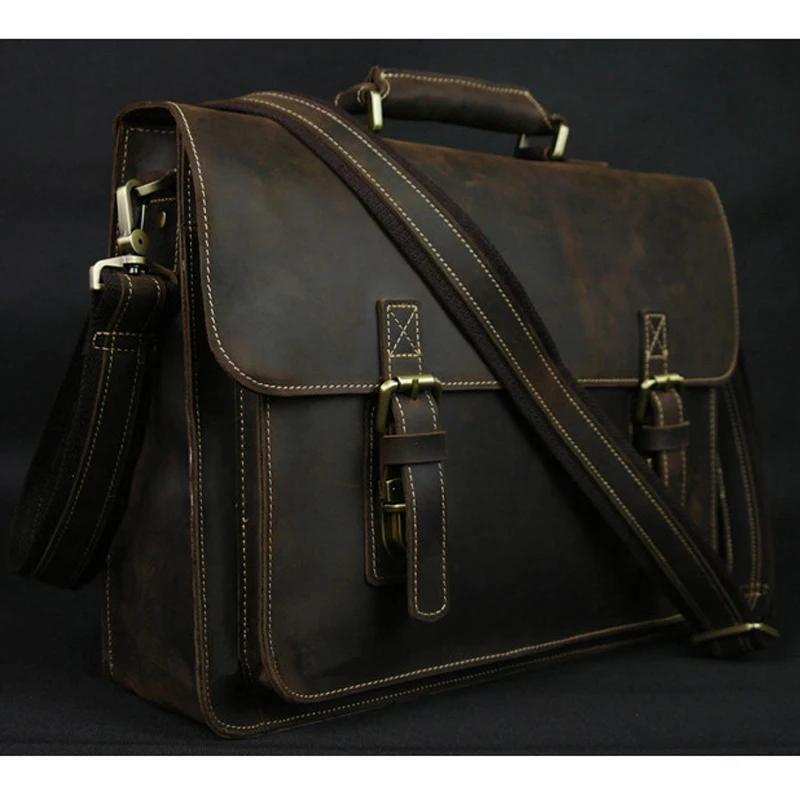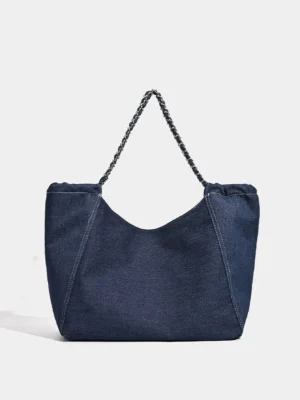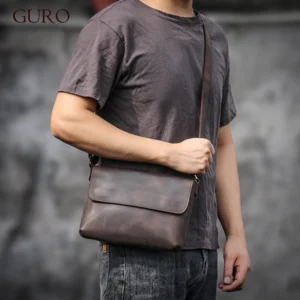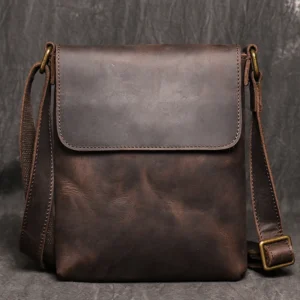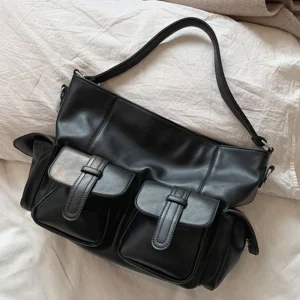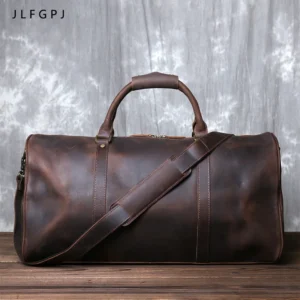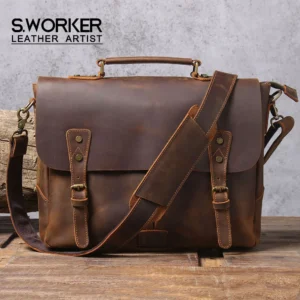Understanding Your Daily Needs: The Foundation of Your Choice
A messenger bag is more than just a stylish accessory—it’s a daily companion that carries your essentials while complementing your lifestyle. Whether you’re rushing between meetings, hurrying to classes, or navigating busy city streets, the right messenger bag can make your day smoother and more organized.
Before diving into specific features or materials, it’s crucial to identify exactly what you need your bag to do. This foundation will guide all your subsequent choices and help you avoid the disappointment of a bag that looks great but fails to serve your practical needs.
Different lifestyles demand different features from a messenger bag:
- Professional users typically need space for laptops, documents, chargers, and perhaps a lunch container
- Students might prioritize textbook capacity, multiple compartments for supplies, and durability
- Active commuters (especially cyclists) require secure closures, weather resistance, and comfortable carrying systems
- Casual users might focus on versatility, style, and enough room for daily essentials
To make the best choice, create an inventory of items you carry daily. Physically gather these items and consider:
- Size and dimensions of your laptop or tablet (measure diagonally across the screen)
- Number of accessories (chargers, mice, power banks)
- Additional devices or documents
- Personal items (wallet, keys, water bottle, snacks)
- Any specialized equipment for your profession or hobbies
When measuring your devices, be sure to measure the entire dimensions—not just the screen size. A 15-inch laptop screen typically requires a larger compartment than just 15 inches, as the frame adds extra size. Add about an inch of clearance for easy insertion and removal.
The everyday use messenger bags that work best are those precisely matched to your routine. Understanding the versatility of messenger bag use will help you identify which features matter most for your situation. As you begin exploring leather messenger bags and other options, keep your personal inventory in mind as your guiding compass.
Key Features to Evaluate: Size and Capacity
Once you understand your daily carrying needs, size and capacity become the next critical considerations. Messenger bags typically measure their capacity in liters, with dimensions expressed as height x width x depth.
Finding the perfect size—what we might call the “Goldilocks zone”—means striking a delicate balance. Too small, and you’ll struggle to fit everything; too large, and you’ll carry unnecessary weight while the bag looks bulky and cumbersome.
Most daily messenger bags fall into these general capacity ranges:
- Small (6-10 liters): Ideal for minimalists carrying just essentials—phone, wallet, keys, small tablet
- Medium (11-15 liters): Perfect for most daily commuters—accommodates laptops up to 15”, notebooks, and personal items
- Large (16-20 liters): Suited for those carrying additional gear—larger laptops, lunch containers, gym clothes
- Extra-large (20+ liters): Specialized use for those with substantial carrying needs
For laptop compatibility, focus on dedicated protection rather than just space. Look for:
- Padded laptop compartments with secure closures
- Suspended design that keeps your device from hitting the bottom of the bag
- Proper dimensions (slightly larger than your device)
- Protection on all sides, not just the back and front
Remember that capacity affects not just what you can carry but how comfortable the bag feels. A properly sized bag distributes weight evenly and sits correctly against your body. Oversized bags tend to sag or bounce uncomfortably during movement, while undersized bags force compromises on what you can bring along.
Keeping your laptop protected is a top priority for most messenger bag users. Understanding proper laptop storage practices will help extend your device’s life. For those specifically needing substantial device protection, professional laptop messenger bags offer specialized features designed to safeguard valuable electronics.
Material Selection: Balancing Durability, Weather Protection and Style
The material of your messenger bag affects nearly every aspect of its performance—from longevity and weather resistance to weight and appearance. Each material offers distinct advantages and potential drawbacks worth considering.
| Material | Durability | Weather Resistance | Weight | Maintenance | Style Profile |
|---|---|---|---|---|---|
| Canvas | High | Moderate (waxed canvas is better) | Medium | Occasional cleaning | Casual to business-casual |
| Nylon | Very high | High | Light | Simple wiping | Modern, technical |
| Leather | High (improves with age) | Moderate (needs treatment) | Heavy | Regular conditioning | Professional, timeless |
| Polyester | Medium | Medium to high | Very light | Machine washable (often) | Casual, practical |
| Tarpaulin | Very high | Excellent | Medium | Simple cleaning | Urban, contemporary |
Quality construction matters as much as the material itself. Look for these hallmarks of durability:
- Reinforced stitching at stress points
- Bar tacking at strap connections and corners
- Quality metal hardware rather than plastic
- YKK or other reputable brand zippers
- Bound or finished seams
- Consistent stitching with no loose threads
Weather protection varies significantly between materials. While full waterproofing might seem ideal, it often comes with tradeoffs in breathability, weight, or flexibility. Many professionals prefer water-resistant options with additional protection available when needed.
Full-grain leather develops a unique patina over time, becoming more attractive with use, while ballistic nylon offers superior tear resistance for demanding environments. Waxed canvas provides a heritage look with surprisingly good water repellency.
The choice between canvas and leather messenger bags comes down to personal preference and intended use. For those wanting the best of both worlds, canvas-leather combination messenger bags offer a compelling blend of lightweight durability with professional accents.
Comfort and Ergonomics: Carrying Systems That Work
Even the most beautiful, perfectly sized messenger bag becomes useless if it’s uncomfortable to carry. The shoulder strap—the defining feature of any messenger bag—deserves careful attention.
A well-designed carrying system features:
- Shoulder strap width: Wider straps (at least 2 inches) distribute weight more evenly across your shoulder
- Adequate padding: Dense, non-compressing foam prevents the strap from digging into your shoulder
- Smooth adjustment mechanism: Allows easy customization without slipping during use
- Cross-body stability: A proper messenger bag should sit securely against your back when properly positioned
- Stabilizer strap option: An additional strap that wraps around your waist or chest for active movement (especially important for cyclists)
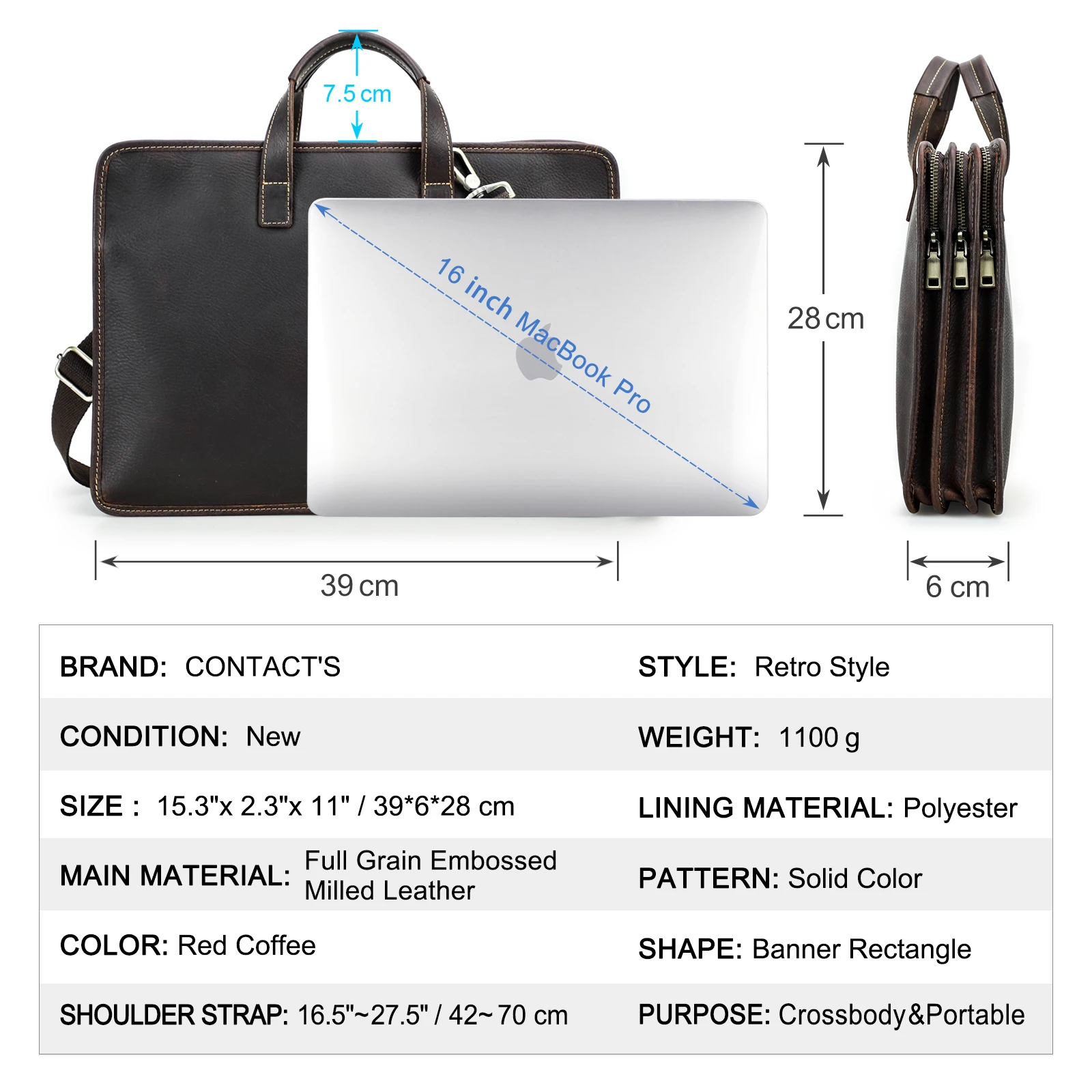
Back panel design significantly impacts comfort during extended wear. Look for:
- Light padding that conforms to your body
- Breathable materials or air channels that reduce heat buildup
- A slight curve that matches your natural posture
Remember that the empty weight of your bag contributes to overall carrying comfort. Materials like leather add inherent weight before you even place items inside. As a general guideline, try to keep the total weight (bag plus contents) under 10-15% of your body weight for comfortable daily carrying.
Proper positioning makes a tremendous difference—the bag should sit at the middle or lower back, not sagging toward your hip. Understanding how to wear a leather messenger bag correctly can prevent shoulder and back strain. For daily commuting and regular use, explore messenger bags designed specifically for daily comfort with ergonomic features that make a noticeable difference over time.
Organization Systems: Keeping Your Essentials Accessible
The internal organization of your messenger bag can be the difference between effortless access and frustrating searches for buried items. Effective organization isn’t about having the most pockets—it’s about having the right pockets in the right places.
Well-designed messenger bags typically feature:
- A spacious main compartment for larger items
- A padded laptop sleeve or compartment (often against the back panel)
- Several medium-sized pockets for accessories and chargers
- Quick-access pockets for frequently used items (phone, transit cards)
- Pen slots and smaller organizational dividers
- At least one zippered security pocket for valuables
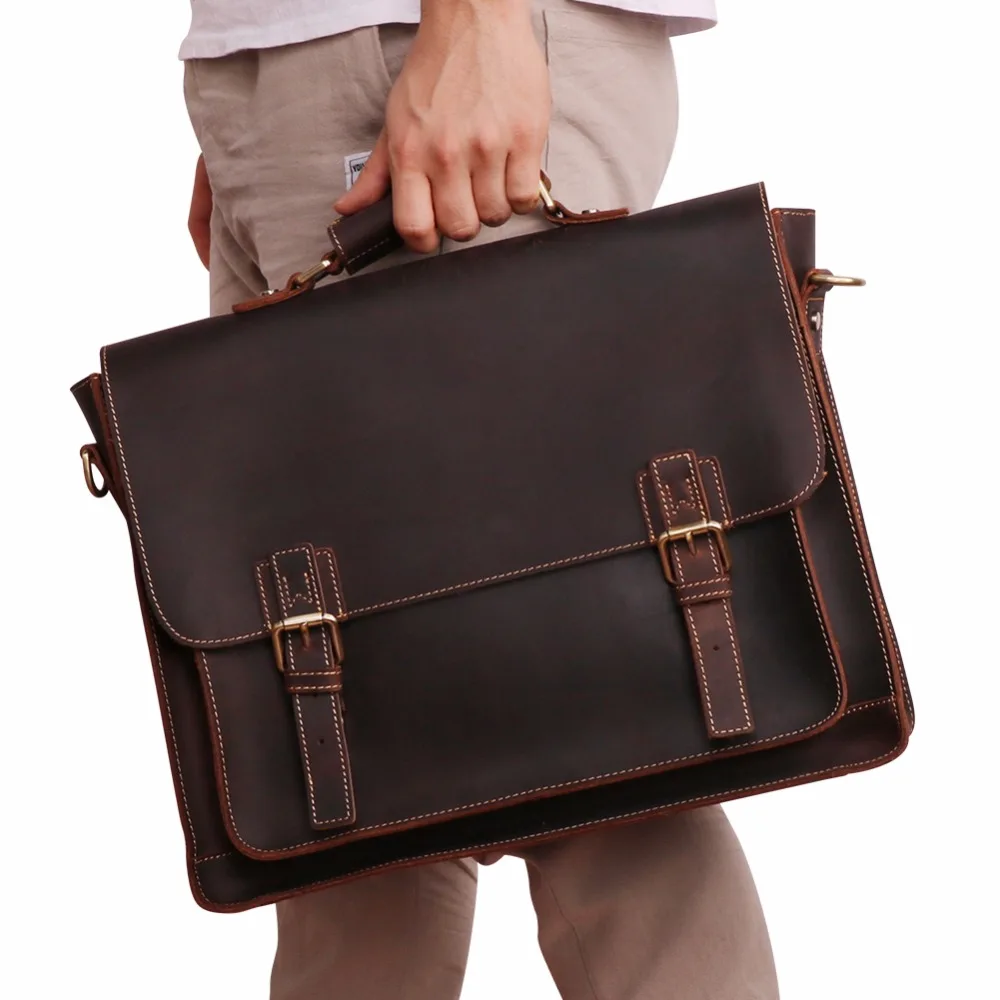
The visibility inside your bag dramatically affects usability. Dark-colored linings might look sleek but can turn your bag into a “black hole” where items disappear. Lighter interior fabrics make contents much easier to see and retrieve. Some premium bags feature contrasting interior colors specifically for this reason.
Consider how you access your bag throughout the day. If you frequently need items while standing on public transit, external quick-access pockets become essential. If you typically set your bag down before retrieving items, internal organization might take priority.
Be wary of over-organization—too many small, specialized pockets can be as frustrating as too few. The ideal system provides flexibility for changing daily needs rather than forcing you into a rigid arrangement.
Mastering messenger bag essentials involves developing personal organization systems that work with your bag’s design. Quality options like full-grain messenger bags often feature thoughtful organizational elements that balance simplicity with functionality, allowing you to develop routines that save time and reduce stress during your day.
Closure Systems and Security: Balancing Access and Protection
How your messenger bag closes affects not just security but also weather protection, accessibility, and even the bag’s overall aesthetic. Different closure systems serve different priorities:
Buckles and Clasps:
– Traditional appearance with heritage appeal
– Secure closure that rarely opens accidentally
– Weather protection from overlapping flap design
– Can be slower to access contents
– May create noise when opening/closing
Zippered Closures:
– Fast, one-handed operation
– Excellent security when closed
– Prevents items from falling out when bag tips
– Potentially vulnerable to water ingress at seams
– May fail mechanically over time
Hook-and-Loop (Velcro):
– Extremely quick to open and close
– Moderate security
– Can be operated silently by careful peeling
– Tends to collect debris and wear out over time
– Creates distinctive ripping sound (problematic in quiet settings)
Magnetic Closures:
– Nearly silent operation
– Quick access without looking
– Clean, minimalist appearance
– Generally less secure than other options
– May not hold securely when bag is overfilled
The flap-over design characteristic of messenger bags provides inherent weather protection beyond the closure system itself. When properly sized, this flap shields the bag’s contents from rain and splash even when the primary closure isn’t secured.
For additional security, look for:
– Hidden pockets positioned against your body
– Interior zippered compartments for valuables
– RFID-blocking pockets for credit cards and passports
– Lockable zippers for high-security needs
The best everyday messenger bag functionality balances security with convenience appropriate to your environment. Those appreciating traditional designs might prefer the classic security of vintage-style messenger bags with their time-tested buckle closures and generous protective flaps.
Style Considerations: Matching Your Professional Image
While functionality should drive your primary decision-making, your messenger bag makes a visual statement about your professional identity. The right aesthetic choice communicates attention to detail and complements your overall presentation.
Messenger bags generally fall into distinct style categories:
- Classic/Traditional: Typically leather or canvas with metal hardware and buckles—communicates established professionalism and timeless taste
- Modern Minimalist: Clean lines, limited external details, monochromatic appearance—suggests contemporary efficiency and streamlined thinking
- Technical/Performance: Synthetic materials, visible water-resistant features, modular attachments—indicates practical innovation and adaptability
- Vintage/Heritage: Weathered materials, brass hardware, visible craftsmanship—conveys appreciation for tradition and lasting quality
- Executive: Premium materials, refined hardware, subtle branding—projects authority and established success
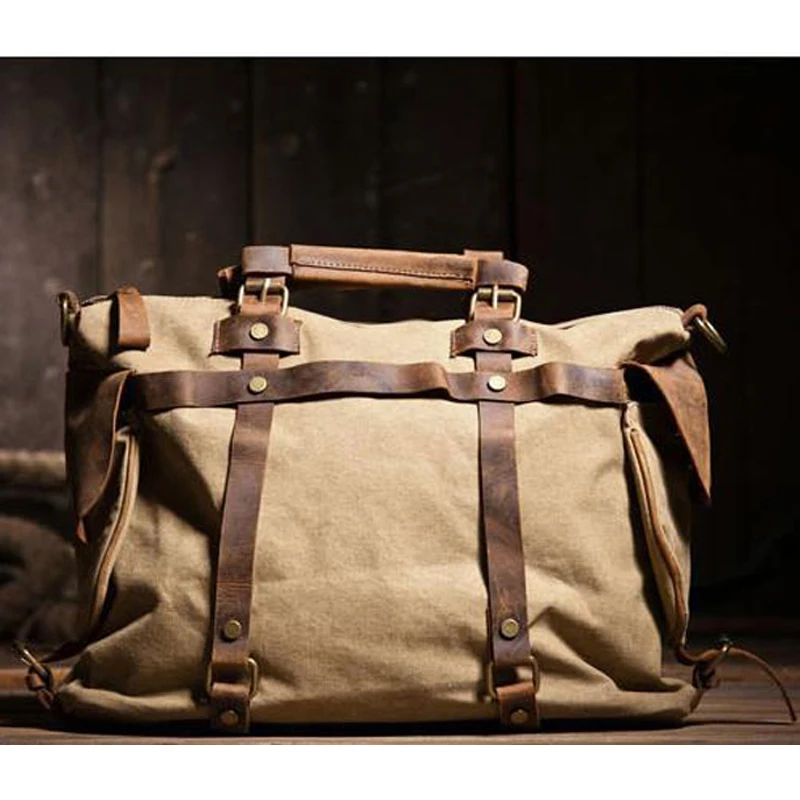
Color selection significantly impacts versatility. Neutral tones (black, brown, navy, olive) pair easily with various professional wardrobes and remain appropriate across seasons. While bolder colors make a stronger statement, they may limit versatility or feel dated more quickly.
Different professional settings have different unspoken expectations:
– Traditional corporate environments often favor conservative leather options
– Creative industries welcome more distinctive and unique designs
– Academic settings embrace both heritage styles and practical functionality
– Technology sectors tend toward modern, innovative designs
The hardware and detailing on your bag (buckles, zippers, stitching) contribute significantly to its overall aesthetic. These elements should harmonize rather than compete—too many different metal finishes or contrasting elements can make a bag look disjointed.
Styling a leather messenger bag effectively means considering your entire professional wardrobe and personal style. For those seeking to make the right impression, our men’s professional leather messenger collection offers options suitable for various professional environments while maintaining timeless appeal.
Making an Informed Decision: Practical Selection Steps
With numerous options available, using a systematic approach helps narrow down choices to find your ideal daily messenger bag:
Prioritize your non-negotiable features
Create a list of must-have features based on your needs assessmentSet a realistic budget range
Quality messenger bags can range from $50 to $500+, with significant durability and feature differencesResearch reputable brands
Look for companies with established reputations and positive customer feedbackExamine reviews critically
Pay special attention to long-term reviews that mention durability and comfortTest in person when possible
Visit stores to physically handle bags and test:
– How the bag feels when loaded with weight
– Ease of accessing internal compartments
– Comfort of the strap on your shoulder
– Overall proportions against your bodyConsider warranty and return policies
Quality brands stand behind their products with meaningful guarantees
When evaluating online reviews, look beyond star ratings to identify specific pros and cons mentioned repeatedly. Pay particular attention to comments about strap comfort, durability of closures, and whether the bag meets capacity expectations.
Remember that quality messenger bags often represent an investment. While the initial cost might be higher, a well-made bag can last many years, making the cost-per-use quite reasonable. Signs of quality construction that justify higher prices include:
- Full-grain leather (not genuine leather or bonded leather)
- Metal hardware instead of plastic
- Reinforced stress points
- Clean, consistent stitching
- Thoughtful interior details
- Robust warranty coverage
The ultimate guide to durable messenger bags provides deeper insight into quality indicators. For those specifically wondering about value propositions, understanding whether leather messenger bags are worth the investment can help make an informed decision that balances cost with long-term satisfaction.
Beyond the Purchase: Accessories and Maintenance
Getting the most from your messenger bag involves both complementary accessories and proper maintenance routines.
Useful accessories to consider:
– Strap pads for additional shoulder comfort
– Water-resistant cover for severe weather
– Cable organizers for electronic accessories
– Modular internal dividers for customized organization
– Luggage pass-through strap for travel convenience
Proper maintenance varies by material but generally includes:
For leather bags:
– Regular cleaning with appropriate leather cleaners
– Conditioning several times yearly to maintain suppleness
– Protecting from extended sun exposure and extreme temperatures
– Allowing to dry naturally if it becomes wet
– Treating with leather protector to enhance water resistance
For canvas bags:
– Spot cleaning with mild soap and water
– Occasional gentle brushing to remove surface dirt
– Applying canvas protector to enhance water resistance
– Ensuring complete drying before storage
For synthetic bags:
– Wiping with damp cloth and mild detergent
– Checking and lubricating zippers periodically
– Washing according to manufacturer instructions when needed
Proper storage extends your bag’s lifespan—store it standing upright or hanging rather than crushed under other items. Stuff the bag lightly with tissue paper when not in use to help maintain its shape, especially with leather options.
Canvas & Leather Messenger Bag, Leather Commuter Tote
$80.41 Select options This product has multiple variants. The options may be chosen on the product pageCrazy Horse Leather Satchel, Men's Leather Satchel, Men's Professional Leather Messenger, Vintage Style Messenger Bag
$132.70 Select options This product has multiple variants. The options may be chosen on the product pageBrown Leather Messenger Bag, Men's Leather Satchel, Men's Professional Leather Messenger
$118.87 Select options This product has multiple variants. The options may be chosen on the product pageBlack Leather Messenger Bag, Black Leather Work Tote, Faux Leather Work Tote
$101.88 Select options This product has multiple variants. The options may be chosen on the product pageCrazy Horse Leather Satchel, Full Grain Messenger Bag, Men's Leather Satchel
$430.41 Select options This product has multiple variants. The options may be chosen on the product pageCrazy Horse Leather Satchel, Men's Classic Leather Briefcase, Professional Laptop Messenger
Price range: $460.43 through $536.25 Select options This product has multiple variants. The options may be chosen on the product page
Regular inspection allows you to address wear before it becomes a significant problem. Pay special attention to strap attachments, corners, and closure mechanisms, as these typically experience the most stress.
For detailed maintenance information specific to higher-end options, our guide to caring for leather work bags provides comprehensive instructions. Those preferring alternative materials might consider vegan leather messenger bags, which offer their own advantages and specific care requirements.
Common Pitfalls to Avoid When Choosing a Messenger Bag
Even with careful consideration, certain common mistakes can lead to disappointment with your messenger bag purchase:
Prioritizing style over function
The most beautiful bag becomes frustrating if it doesn’t meet your practical needs. While aesthetics matter, they should be considered after fundamental requirements are met.
Incorrect sizing
Choosing a bag that’s too small creates daily frustration, while oversized bags become cumbersome and encourage overpacking. Be honest about your actual needs rather than aspirational minimalism.
Ignoring strap design
A poorly designed strap turns even a perfect bag into a literal pain. Never compromise on carrying comfort, especially if you travel long distances or carry significant weight.
Undervaluing weather protection
Water-resistant isn’t the same as waterproof. Consider your local climate and commuting method when evaluating weather protection features.
Choosing trendy over timeless
Highly distinctive designs might look dated quickly. Consider whether the bag’s style will still feel appropriate years from now.
False economy in materials
Saving money initially often leads to premature replacement costs. Quality materials might cost more upfront but typically offer better value over time through extended durability and better aging characteristics.
Overlooking weight when empty
Some materials and designs add significant weight before you even add contents. Test bags with realistic loads to assess true carrying comfort.
For those seeking reliable daily options that avoid these common pitfalls, exploring best leather messenger bags for daily use can provide guidance toward well-balanced choices that deliver on both functionality and style.
Is a Messenger Bag Right for Every Situation? Alternatives to Consider
While messenger bags excel for many daily scenarios, they’re not universally ideal. Understanding their limitations helps determine if alternative bag styles might better serve specific needs.
When messenger bags shine:
– Urban commuting with moderate loads
– Situations requiring frequent access to contents
– Professional environments where appearance matters
– When carrying primarily flat items (laptops, documents)
– For those who prefer asymmetrical carrying styles
When alternatives might be better:
– Carrying very heavy loads (backpacks distribute weight better)
– Extensive walking or standing (two-strap designs reduce fatigue)
– Highly formal business settings (briefcases offer traditional professionalism)
– Carrying predominantly bulky or irregularly shaped items
Hybrid designs increasingly blur traditional boundaries, offering alternatives worth considering:
- Convertible briefcase-messenger bags combine professional appearance with comfortable carrying options
- Backpack-messenger hybrids offer multiple carrying positions for different situations
- Tote-messenger combinations provide open-top access with messenger-style carrying options
- Sling bags offer smaller, lighter alternatives for minimalist carry
The right bag style depends on honest assessment of your daily routine. Ask yourself:
– How long do you typically carry your bag without setting it down?
– Do you access contents frequently while standing or moving?
– How formal is your typical environment?
– Do you experience physical discomfort with certain carrying styles?
For those considering more traditional professional options, our guide on how to choose the perfect leather briefcase explores an alternative with its own advantages. Active professionals might also appreciate the versatility of leather commuter totes that offer different carrying and access options.
The perfect daily messenger bag balances your personal needs, professional environment, and carrying preferences. By understanding the key considerations outlined in this guide, you’ll be well-equipped to make a choice that serves you reliably for years to come.

